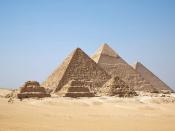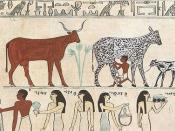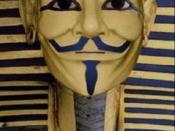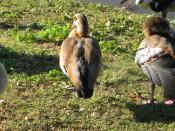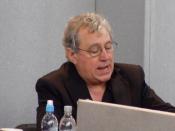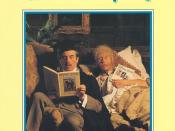I chose to review the documentary The Hidden History of Egypt, presented by Terry Jones. The reason I chose this documentary is because I had prior knowledge about Terry Jones in a comical sense through Monty Python and Ripping Yarns, hence I had some expectations about it. I also think that of the three documentaries we viewed, this one was the most engaging as it presented aspects of factual information in a humorous manner.
The Hidden History of Egypt had a greater emphasis on the everyday life of the Egyptians, unlike the other documentaries we watched which dealt more with the pyramids and tombs of Egypt. In this documentary Terry Jones walked through the ruins of ancient Egyptian houses, sampled Egyptian food, dressed like an ancient Egyptian and visited the some tombs of an "average" Egyptian. Throughout the documentary Jones's manner was very relaxed and the documentary was almost a spoof of "traditional" documentaries.
He used comedy and visuals to communicate with the audience, such as dressing up as an Egyptian, and this worked with immense success. In the documentary there was a small amount of archival footage used, but unlike most documentaries this one did not rely on it. The documentary featured Dr. Joanne Fletcher, an Egyptologist, who explained to the audience a variety of facts relating to ancient Egypt. The purpose of bringing an 'expert' into the documentary probably had the effect of providing credibility to it.
The documentary focused on six different aspects of ancient Egyptian culture. These were: tombs, housing/craftsmen, agriculture, food and drink, engineers/languages and dress and makeup. The documentary started with Terry Jones and Joanne Fletcher investigating the tombs of typical Egyptians and how the hieroglyphs, within those tombs, told their stories. An interesting fact they shared was that the tombs were built in the Egyptians spare time. After this Terry and Joanne looked at the housing of ancient Egypt and then compared it to the housing of modern Egypt. The documentary showed the ruins of Deir-el-Medina and the inside an ancient Egyptian home that was there. This home had a front room for guests, a "family" room, a kitchen and bedrooms. It also showed us that the ancient Egyptians had a "refrigerator" which consisted of a hole in the ground that was kept covered in order to keep the food cool. A similarity between the ancient Egyptian home and the modern Egyptian home was that in both cases the family slept on the roof in summer, in order to keep cool.
From housing to agriculture, the documentary explained how the flooding of the Nile was crucial to ancient Egyptian society, as it brought silt down from Ethiopia and Uganda. The silt that came with the flooding fertilized the land. The fertile land was so important to the Ancient Egyptian that they named their country after it; they called it "Khemet" or "Black Land". The land that was not touched by the flood was called the "Red Land" or "Deshret", from which we get our word desert.
After the Egyptians grew their food they had to eat it and this topic was explored next in the documentary. It demonstrated that bread and beer was the staple diet of ancient Egypt and it was what the pyramids were "built on". Other foods included salad, fish and roast duck; however this was more for the higher status Egyptians.
The ancient Egyptian engineers produced superb buildings and in some cases these are more skilled than what we see today. An excellent example is the case of Abu Simbel. Such was the ingenuity of this construction, that in the mid 20th century when the Egyptian government built a dam to prevent the Nile from flooding, it was necessary to move Abu Simbel. This was because the dam was going to be built on the same location. So the government took the temple apart piece by piece and relocated it to higher ground. In the original temple there were three statues of gods that were lit up by the sun twice a year, however when the temple was relocated the engineers were not as skilled and could only light one of the gods up.
The final section of the documentary discussed clothing and makeup. This part was a particular highlight in the documentary as Terry Jones dressed up as an ancient Egyptian. He looked most convincing! Make up was an important part of Egyptian society, so important it caused the first ever strike, in which workers stopped working demanding more makeup and moisturisers. An interesting point I learnt was that the black makeup the ancient Egyptians wore, reflected the light acting as a type of sunglasses. The clothing worn in ancient Egypt was very simple and consisted of a loin cloth and a "long t-shirt", making it very comfortable and cool.
I believe this documentary had many strengths, and one of the main ones was that it was shot on location. Terry Jones was actually in Egypt, as opposed to filming in a studio or CGI. In Quest for Immortality the majority of it was certainly filmed in tombs or just around Giza or Saqqara. Whilst in Pyramid Beyond Imagination a lot of that was CGI. A great strength of The Hidden History of Egypt, was when Terry Jones was walking around the ruins of houses and we were able to get a glimpse of "modern" Egypt. This was effective in engaging the audience as the whole documentary seemed more interactive. Another strength of this documentary was the use of comedy and the general relaxed manner in which Jones presented it. It was a change from the other documentaries which were very serious. When Jones dressed up as an ancient Egyptian this provided the audience with a good visual of what the "average" ancient Egyptian looked like, and he also mixed this with comedy by walking down the streets of modern day Egypt.
The only weakness with this documentary was Dr. Joanne Fletcher, the Egyptologist. I believe that she became too involved in the documentary and it reached a point where it seemed she was the main presenter and Terry Jones was just in the background. I believe she should have been given some cameo appearances to provide some historical facts, and then allow Jones to "lead" the documentary and feature more frequently. Also when Jones was by himself that was when his comedic side showed most prominently, however whenever Joanne was onscreen Jones just followed her around. During these times I found myself less connected with what was being said.
I do not believe that you can say films are not as good as traditional text books in teaching. It is not a matter of one or the other, Rather it is about engaging students in the topic, developing their interest to want to learn more. To do this it makes sense to use a range of resources. This can include films, books, Internet and field trips. It is also about recognizing that different students learn in different ways. By providing a range of approaches and activities on a topic, student learning styles are more likely to be accommodated.
This is one of my favourite documentaries because it really brought ancient Egypt to life. By looking at the ancient daily life of the Egyptians, and then having a glimpse of that life in modern Egypt it certainly kept me interested, especially with the comical style of Terry Jones. However it achieved more than this for me. As I have been fortunate enough to have traveled around Egypt, I do have some first hand knowledge of modern day Egypt. This film very successfully for me provided a link between what I saw on my trip and what happened 4000 years ago. No other documentary has ever done this before. It was quite a different perspective on ancient Egypt and very refreshing.
Bibliography: Jones, Terry, prod. "The Hidden History Of Egypt."
